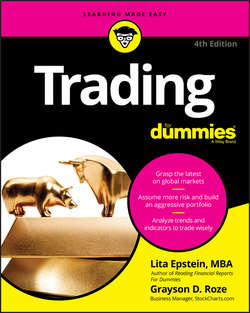Читать книгу Trading For Dummies - Lita Epstein - Страница 12
На сайте Литреса книга снята с продажи.
Part 1
Getting Started with Trading
Chapter 1
The Ups and Downs of Trading Stocks
Understanding Fundamental Analysis
ОглавлениеYou’ve probably heard the phrase “It’s the economy, stupid.” Well that’s true, and we show you how understanding the basics of the business cycle can help you improve your trading successes. In Chapter 5, you find out how to identify periods of economic growth and recession and how these differing periods impact bull and bear stock markets. We also explore sector rotation and how to use it to pick the right sectors for your trading activities.
You can also discover plenty of information about how money supply, inflation rates, deflation, joblessness, and consumer confidence impact the mood of the market and stock prices and how the economy can be driven by how confidently (or not) political and monetary leaders speak out about it. We discuss the role of the Federal Reserve (Fed) and how when the Fed Chairman speaks, the markets listen.
Essentially fundamental analysis looks at company financial performance, as well as the performance of the economy, to analyze the future profit potential of a stock or other equity purchase. Understanding how the economy works isn’t the only fundamental analysis tool that’s important to you. You also need to read financial statements to understand the financial status of the companies you want to buy. We delve into financial statements in Chapter 6.
A company’s income statements, on the other hand, give you a look at the results of the most recent period and provide a basis for comparison with prior years and periods. You can use these statements to look at whether revenues are growing, and if they are, by what percentage. You also can see how much profit the company is keeping from the revenue it generates. The cash‐flow statement shows you how efficiently a company is using its cash and whether it’s having problems meeting its current obligations. The balance sheet gives you a snapshot of a company’s assets and liabilities and stockholder’s equity.
You can use this information to develop your own estimate of a company’s growth and profit potential. In Chapter 6, we show you how to do a few basic ratio calculations that you can use to compare similar stocks and then choose the one with the best potential.
Analysts use this information to project a company’s financial growth and profits. You never should depend entirely on what analysts say, but you always should do your own research and collect the opinions of numerous analysts. One of the best ways to find out what analysts are saying and what aspects of the financial statements may raise a red flag is the analyst call. In Chapter 7, we explain how you can listen in on these calls and understand the unique language used in them to make better choices when selecting stocks. We also discuss the pros and cons of using analyst reports.
